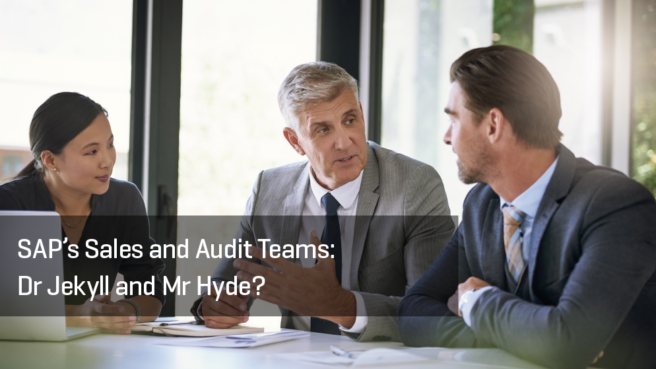SAP´s Sales and Audit Teams: Dr Jekyll and Mr Hyde

Since SAP’s official announcement on April 10th, concerning sales, audit and license pricing, everyone has been talking about the licensing model that came out of talks between SAP and its user groups, ASUG and DSAG. To date, SAP has announced the concept, introduced a price list and has provided a very basic report to estimate Digital Access Document usage.
The introduction of nine document types could be seen as the logical next-step for the digital age – after SAP’s announcement last year that Procure-to-Pay (P2P) and Order-to-Cash (O2C) Indirect Use would be addressed via order licensing metrics. We know from the price list that the most expensive document will cost 0.50€, scaling down with higher volumes.
This announcement was well-timed before the SAPphire Now conference in Orlando, allowing SAP CEO, Bill McDermott to focus on C/4 HANA and not have to discuss licensing in that forum.
Source: SAP® 2018
A completely different topic almost got lost in the noise around the new Digital Access Documents licensing – the announcement that SAP were formally separating Sales and the SAP Global License Audit and Compliance Team (GLAC) at a global level.
The separation recalls the story of Dr. Jekyll and Mr. Hyde. He succeeds in separating the bad part of himself into its own person. The difficulty here is deciding which one is Mr. Hyde!
The separation is intended to promote a spirit of trust and customer empathy, with consistency across SAP’s license auditing and compliance practices. Sales can no longer initiate or threaten an audit, and neither can they cancel one. Clear rules of engagement have been published by SAP:
Source: SAP Global License Audit and Compliance Update April 2018
Is SAP concentrating on the enforcement of its IP rights, or is it a strategic move by the ERP giant?
While some may argue that the license audit offers the licensee insight into complex license terms, most customers are still confused about products, license measurements and metrics.
The goals are the same for Dr. Jekyll and Mr. Hyde: to increase sales or possibly introduce new products, technologies and/or licensing models that meet the manufacturer’s goals.
With the announcement, there is a clear separation – the license audit team will drive the compliance discussion to advance the enforcement of contractual rights through various system measurement approaches such as the annual USMM / LAW submission, audit verification and/or indirect access evaluation, while the sales team will focus on being a trusted consultant, communicating product features and values.
As SAP is upgrading the resources in their audit team, it’s safe to assume that in the future there will be more and more audits. Customers can also assume that the auditors’ bonuses are no longer tied to the revenues of their sales organization, but to the additional revenue they generate through audits.
Starting in November, SAP will automatically detect which of the nine document types mentioned above a company uses, during the annual measurement by the USMM tool.
In the official whitepaper “SAP Global License Audit and Compliance Update”, SAP presented how auditors will assess indirect access license requirements:
“SAP license audits are to be conducted in the spirit of trust and customer empathy. After listening to customer feedback, SAP is taking action to clarify essential rules of engagement and to promote consistency across its license auditing and compliance practices.”
Source: SAP Global License Audit and Compliance Update April 2018
SAP have published options for existing SAP ERP customers, under the new licensing metrics, with the option being for them to “Do Nothing”.
Source: SAP ERP Pricing for the Digital Age April 2018
In reality, there may be no such option.
With the delivery of the new USMM tool, Indirect Access Documents will be measured, and SAP will be in a position to force a discussion around license exchange in the next iteration of contract negotiations. If a customer decides to stay on their original contract, they could be subject to open-ended indirect usage exposure and penalties – remember the Diageo court case?
To get the best outcome in license negotiations, you’ll need to make sure you know exactly what is in your existing contract, optimize your license consumption and either exchange unused licenses or close them down. If a contract is adapted to the new licensing model, it is highly likely that new passages and definitions (e.g. authorization-based user licensing) will overwrite old, useful parts of the contract.
During contract negotiations, there may be additional costs and complexities involved in reworking your contract. SAP will then suggest switching directly to S/4 HANA to regain compliance as quickly as possible. This fits with SAP’s declared goal to bring as many organizations as possible on to S/4 HANA before 2024.
It is obvious why SAP is so keen to unify and rationalize contracts as much as possible. Many agreements are often decades old and contain passages that no longer fit new technologies (e.g. cloud). In the many years we have been in business, we have not seen two SAP contracts that are the same.
The declared goal should be to create a win-win situation between software manufacturers and licensees. By simplifying complex licensing terms and conditions and providing transparency of use through license management solutions, customers can leverage this valuable insight to successfully negotiate better contracts with SAP, track compliance and achieve substantial cost savings.
Talk to us about how we can help you identify your license requirements and current usage. Snow Optimizer for SAP® Software ensures full visibility of your entire SAP estate, enabling you to optimize all license types and authorizations.